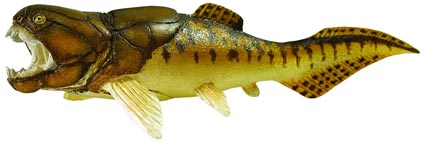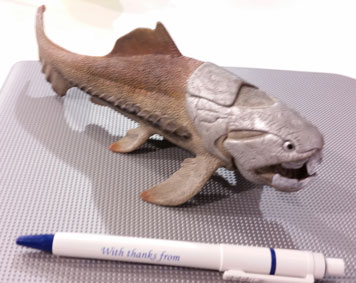The Mystery of Dunkle’s Bones
A Puzzle about Dunkleosteus – A Bony Problem
The apex marine predator during the Late Devonian was the huge placoderm Dunkleosteus. Placoderms (the term means plated or armoured skins), were a hugely successful group of primitive jawed fish. They evolved in the Silurian and rapidly diversified to become the main predators along with the first sharks during the Devonian.
Ranging in size from a few centimetres to giants like Dunkleosteus at over 8 metres long, the placoderms were extremely successful. However, the placoderms became extinct at the end of the Devonian and as far as the fossil record shows, no placoderms survived into the Carboniferous. A number of marine families became extinct at the end of the Devonian (approximately 354 million years ago), many fish species become extinct and also organisms such as corals, brachiopods, bivalve molluscs and sponges. Tropical reef-dwelling animals seem to have been the most badly affected. The exact causes of the Devonian mass extinction are unknown.
A Model of Dunkleosteus
Picture credit: Everything Dinosaur
The picture above, shows the Dunkleosteus model from Schleich: Schleich Prehistoric Animal Models.
One of the mysteries surrounding the huge, carnivorous Dunkleosteus (the name means Dunkle’s Bones, as this animal was named after the American palaeontologist D. H. Dunkle), is exactly what this animal looked like. Scientists believe that is lived in the open ocean, and was pelagic (lived above the sea floor). It is likely that it was also nektonic (an active swimmer), however, only the head and thorax of this fish were covered in bony plates.
A number of these bony plates have been preserved as fossils and scientists have a good idea of what the front end of Dunkleosteus looked like. As for the rest of the animal, the lack of fossil remains (rest of the skeleton probably made of cartilage, like sharks) means that scientists have to make an educated guess as to what the animal actually looked like.
Did Dunkleosteus have a shark-like habit? Was it an active hunter, swimming constantly as it lacked a swim bladder like sharks? Or was the bus-sized fish more like an eel with a long slender body, fringed with ribbon-like fins swimming sinuously?
Scientists have used the complete remains of smaller placoderms as the basis for their reconstructions of Dunkleosteus.
A Model of Dunkleosteus (Wild Safari Dino Dunkleosteus)

Picture credit: Everything Dinosaur
In this illustration, Dunkleosteus is modelled on the anatomy of a sleek, predator with a powerful tail providing bursts of acceleration to help it catch prey. The body is broader than in other depictions of this particular placoderm and the tail flukes wider at the bottom to give thrust.
This is the model of Dunkleosteus created by Safari Ltd of the USA and is part of the model series entitled Wild Safari Dinos.
To view the prehistoric animal models in the Wild Safari Prehistoric World range: Safari Ltd. Wild Safari Prehistoric World.


